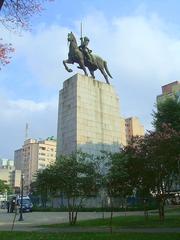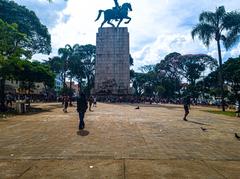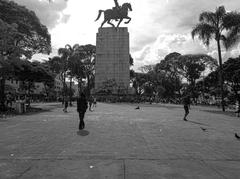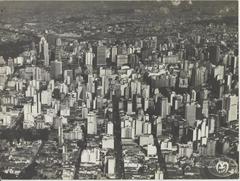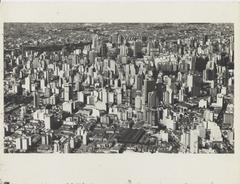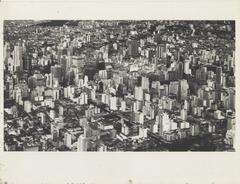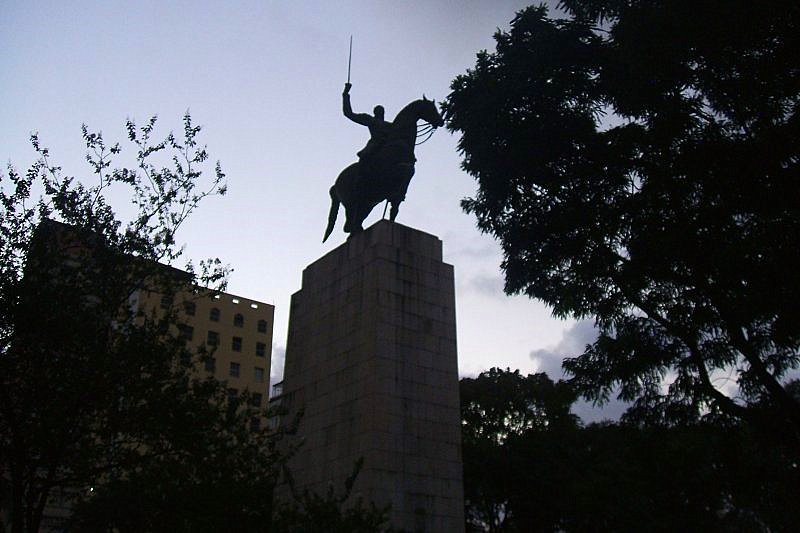
Visiting the Monument to Duque de Caxias in São Paulo, Brazil: Tickets, Hours, and Tips
Date: 14/06/2025
Introduction: Why the Monument to Duque de Caxias is a Must-See in São Paulo
The Monument to Duque de Caxias is a grand tribute to Luís Alves de Lima e Silva—the Duke of Caxias—revered as the Patron of the Brazilian Army and a pivotal figure in Brazil’s 19th-century history. Erected in 1960 and designed by the acclaimed modernist sculptor Victor Brecheret, this colossal equestrian statue, soaring to approximately 48 meters in height, is recognized as the largest of its kind globally. The monument stands in Praça Princesa Isabel in the Campos Elíseos district, anchoring São Paulo’s historical and cultural landscape and symbolizing national unity, resilience, and patriotism.
This detailed guide explores the monument’s historical background, artistic and political significance, visitor information—including free admission, accessibility—and practical travel tips. Whether you are a history enthusiast, art lover, or a traveler exploring São Paulo’s historical sites, this resource will enrich your understanding of one of Brazil’s most iconic landmarks. For up-to-date visitor information, consult official sources such as Museu Histórico do Duque de Caxias e da Taquara, Encontra São Paulo, and Demonumenta.
Table of Contents
- Introduction
- Historical Background
- Artistic and Architectural Significance
- Political and Cultural Impact
- Visitor Information (Hours, Tickets, Accessibility)
- Travel Tips & Nearby Attractions
- Frequently Asked Questions (FAQs)
- Conclusion
- References
Historical Background
Duque de Caxias: The Man and His Legacy
Born in 1803, Luís Alves de Lima e Silva, later known as the Duke of Caxias, was instrumental in shaping the Brazilian state during the 19th century. His leadership in wars such as the Paraguayan War (War of the Triple Alliance) and his roles in quelling internal revolts established his reputation for discipline, strategic acumen, and a commitment to national unity. Caxias also served as a senator and thrice as President of the Council of Ministers during the Empire of Brazil, consolidating the nation’s stability and territorial integrity (Museu Histórico do Duque de Caxias e da Taquara).
Origins and Construction of the Monument
The concept for the São Paulo monument was rooted in the city’s growing stature as a cultural and economic hub, marking a broader national movement to memorialize Brazil’s heroes. Victor Brecheret’s design won acclaim for its monumental scale and modernist vision. Although completed in the late 1940s, the monument’s installation was delayed by urban planning and political debates until its inauguration in 1960 (Demonumenta). Its location at Praça Princesa Isabel reflects São Paulo’s central role in Brazil’s nation-building narrative.
Artistic and Architectural Significance
Monumental Scale and Materials
The monument rises to 48 meters, combining a massive granite pedestal with a dynamic bronze equestrian statue finished in platinum patina. The pedestal, over 25 meters tall, features detailed high and low reliefs narrating key episodes from Caxias’s military and political career. The statue itself, over 16 meters high, is recognized as the world’s largest equestrian sculpture (Encontra São Paulo; Arteeartistas).
Artistic Vision and Reliefs
Brecheret’s modernist approach is evident in the expressive realism of the horse and rider, symbolizing leadership and readiness. The reliefs on the pedestal depict:
- Pacificação: Caxias’s pacification of internal revolts.
- Caxias falando ao povo de Bagé: His engagement with local communities.
- Reconhecimento de Humaitá: Role in the Paraguayan War.
- Batalha de Itororó: A significant military victory.
- Enterro de Caxias: National mourning at his passing.
Each scene is rendered with clarity and emotional impact, reinforcing the monument’s storytelling function (Arteeartistas).
Urban Context
Despite its monumental ambition, the monument’s placement in Praça Princesa Isabel—surrounded by tall buildings and mature trees—limits its visibility, a point of debate among urbanists and historians (Demonumenta). Nonetheless, it remains a focal point within São Paulo’s cityscape.
Political and Cultural Impact
National Symbolism
The monument is a powerful symbol of national unity, military leadership, and civic values. By commemorating Duque de Caxias as the “Patrono do Exército Brasileiro,” it reinforces narratives of patriotism and sacrifice, serving as a site for military ceremonies and public commemorations (Encontra São Paulo).
Contemporary Reflections
In recent years, the monument has become a subject of renewed debate, reflecting on issues of historical memory, representation, and national identity. Events such as the 1991 bombing and contemporary artistic interventions demonstrate its evolving relevance (Demonumenta).
Educational Role
The monument is frequently visited by students and historians and is included in educational tours and public events, fostering civic awareness and historical reflection.
Visitor Information
Location
- Address: Praça Princesa Isabel, Campos Elíseos, São Paulo, SP, Brazil
Visiting Hours
- Park Hours: Open daily from 6:00 AM to 6:00 PM (monument is outdoors and accessible during these hours).
Admission
- Entry: Free for all visitors.
Accessibility
- Wheelchair Access: Paved paths and ramps provide access around the monument, though the pedestal’s elevation limits close access to the statue’s base.
- Public Transport: Nearest metro stations: Luz and Júlio Prestes (10-minute walk). Multiple bus lines serve Avenida Duque de Caxias and Avenida Rio Branco.
Guided Tours
- Availability: Guided tours can be arranged via local tourism offices; digital guides such as the Audiala app offer rich historical content.
Safety Tips
- Visit during daylight for safety and best viewing.
- Use public transport due to limited parking.
- Be mindful of surroundings, especially near Cracolândia.
Travel Tips & Nearby Attractions
Tips for a Rewarding Visit
- Early mornings or weekdays offer quieter experiences and optimal lighting for photography.
- Bring water and wear comfortable shoes.
- Explore the monument’s reliefs and read about the depicted episodes for deeper historical context.
Nearby Attractions
- Monumento às Bandeiras: Another iconic Brecheret work near Ibirapuera Park.
- Luz Station: Historic railway station and museum hub.
- Parque da Luz & Pinacoteca do Estado: Green space and major art museum.
- São Paulo Museum of Art (MASP): Renowned for its modernist architecture and collection.
Frequently Asked Questions (FAQs)
What are the visiting hours?
Park and monument are accessible daily from 6:00 AM to 6:00 PM.
Is there an entry fee?
No, access is free.
Is the site wheelchair accessible?
Yes, the park and paths are accessible; the pedestal area is not.
Are guided tours available?
Tours can be arranged through local tourism offices or experienced digitally via apps.
How do I reach the monument by public transport?
Luz and Júlio Prestes metro stations are nearby; several bus lines serve the area.
Is it safe to visit?
Yes, during daylight hours. Exercise caution, especially in the evening and near Cracolândia.
Conclusion
The Monument to Duque de Caxias is a testament to Brazil’s military history, artistic achievement, and evolving national identity. As the world’s largest equestrian statue, it honors a complex figure whose legacy continues to spark dialogue and reflection. Free to visit and accessible by public transport, it is a must-see for anyone wishing to understand the intersections of history, art, and public memory in São Paulo.
Plan your trip during daylight, leverage digital guides for a richer experience, and explore nearby cultural sites to make the most of your visit. For updates and further information, consult Encontra São Paulo, Museu Histórico do Duque de Caxias e da Taquara, and the Demonumenta project.

